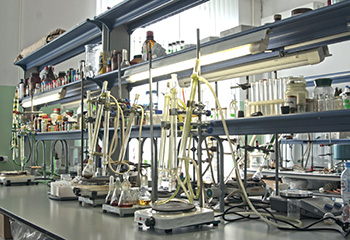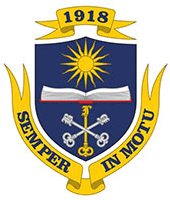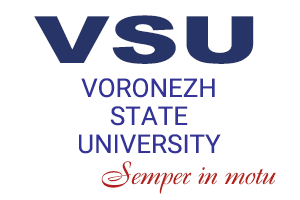Laboratories (Faculty of Chemistry)
- Laboratory of Electrochemical Material Studies and Anticorrosion Protection
- Laboratory of Fine Inorganic Synthesis and Investigation of Inorganic Substances of the Nanotechnologies and Materials Centre for Research and Education
- Laboratory of Membrane and Sorption Separation and Visualisation Methods for Transfer Phenomena in Heterogeneous Systems
- Laboratory of Express and Test Analysis Methods
- Physicochemistry of Metal-Polymer Nanocomposites
- Laboratory of potentiometric multisensor systems for the analysis of aqueous-organic media
Laboratory of Electrochemical Material Studies and Anticorrosion Protection
Industrial partners
- ООО VMP Voronezh
- GK PROTEK
- Innovation Centre Biruch (GK EFKO)
- OOO ElNano
Research area
Thermodynamics and kinetics of heterogeneous multi-stage electrochemical processes as a scientific foundation for preparing new highly active electrode materials, the creation of new principles of electrocatalytic reaction control, and the suppression of corrosion in metals and alloys
Laboratory equipment
- Computer-aided electrochemical systems IPC–Compact, IPC-Pro-L, IPC-Pro
- Frequency response electrochemical analysers FRA‑1
- Unico-2800 spectrophotometer
- Digital metallographic microscope Altami МЕТ 1Т (up to 2,000x magnification)
- Rotating disk electrode with a device for in situ cut of a thin (μm) surface layer
- Rotating disk electrode with a ring
- Unit for in situ photoelectrochemical measurements
- Photocolorimeters
- Conductometers
- Ionomers
- Digital voltmeters
- Power supplies
- Software for quantum chemical calculations GAUSSIAN‑2003 GAUSSIAN‑2009, and WIENN-2K
- Software for multiphysical calculations COMSOL Multiphysics 5.0
- Software Mathematica 11
Available research methods
- Ambulatory electrochemical study method (voltammetry, chronoamperometry, chronopotentiometry)
- Impedance spectroscopy
- Photocurrent and photopotential spectroscopy
- Spectrophotometry
- Optical microscopy
- Quantum-chemical, mathematical, and multiphysical modelling
Challenges
- Creating electro-catalytic active materials for the chemical sources of currents, electrochemical energy storage devices, and sensors
- Deposition of electroplated coatings with functional micro-, nanoelectronics, and anticorrosion protection properties
- Synthesis of semiconductor metal-oxide films for micro- and optoelectronics, photo (electro) catalysis, energy production, and chemical and biological sensory studies
- Establishing the kinetics and mechanism of electrocatalysis processes and hydrogenation of metals and alloys to solve problems of corrosion, electrochemical, and hydrogen energetics
Major projects
- Grant of the Ministry of Education and Science of the Russian Federation in the framework of the state order to higher education institutions for years 2014–2016, project No. 675 “Study of heterogeneous and homogeneous processes in ion exchangers, metal-polymer composites, and alloys”
- Grant of the Russian Foundation for Basic Research No. 09–03–00554-а “Synthesized oxides Cu(I) and Ag(I) in form of a nanofilm and a nanocomposite with a polymer: production and reduction kinetics, chemical inertness, stoichiometry and semiconductor properties”
- Grant of the Russian Foundation for Basic Research No. 08–03–00194-а “Heterogeneous processes in metallic systems with electrochemical, chemical, adsorption, and transport stages: kinetics and thermodynamics”
- Grant of the Russian Foundation for Basic Research No. 06–03–32274-а “Selective anodic dissolution of homogeneous alloys under conditions of oxide and salt formation”
- Grant of the Russian Foundation for Basic Research No. 01–03–33190-а “The role of chemical composition and structural and vacancy defectiveness of homogeneous gold and palladium-containing alloys in the formation of their electrocatalytic activity: kinetics, double layer, and electronic structure”
Laboratory of Fine Inorganic Synthesis and Investigation of Inorganic Substances of the Nanotechnologies and Materials Centre for Research and Education
 Research area
Research area
- Development of synthesis methods and studying the properties of SAS and emulsifiers based on raw materials and wastes of oils and fats production to be used in various industries, including cosmetic, construction, oil-producing, etc.
- Development of new inhibitors of copper corrosion, copper alloys, and steels to be used in various industries, including water supply equipment and coating compositions
- Development of new growth regulators of plants to provide for the agricultural needs
- Development of directed synthesis methods for protein kinase inhibitors with potential anticancer activities
- Development of new blood thinners based on polyazaheterocyclic systems
- Development of methods of analysis for inward raw materials and methods of process monitoring
Industrial partners
- OAO EFKO (Alexeyevka, Belgorod region)
- ZAO Petrochim (Belgorod)
- OOO NaftaEKO engineering company (Voronezh)
Laboratory equipment
- Gas chromatograph – Agilent 7890B/5977A mass spectrometer
- Agilent 6230 accurate-mass time-of-flight (TOF) LC/MS system
- Milestone MicroSynth microwave synthesis system
- Carousel 6 Plus reaction station
- Unic laboratory reactor system for organic synthesis
- PC3004 Vario chemical vacuum station
- КХТВ‑0.15 climatic temperature and humidity chamber
Available research methods
- Parallel controlled combinatorial synthesis of organic compounds, refining the synthesis conditions
- Chromatographic separation of mixtures and mass spectrometry analysis of organic compounds and the study of organic reaction mechanisms
- Electrochemical and full-scale testing of corrosion inhibitors
- Spectral methods for studying organic compounds in UV, visible, and IR spectra
- Studying functional properties of SAS
Challenges
- Development of new SAS for chemical enterprises (SAS and co-SAS for cleaners and emulsifiers during emulsion polymerisation, for pharmaceutical enterprises (as a structure-forming component of medicinal products), for ore mining enterprises (lubricators, emulsifiers, deemulsifiers), for construction enterprises (anti-foaming agents, foam stabilisers, for example, during foam concrete production)
- Development of new anti-corrosion inhibitors for various enterprises, including coating compositions and metalware manufacturers
- Development of new growth regulators of plants with growth enhancement and growth inhibiting effects for agricultural enterprises
- Development of new drug prototypes, including those with potential anticancer activities, blood thinners for medical companies
- Development of best synthesis conditions, development of technical documentation Development of methods of analysis for inward raw materials and end products and methods of process monitoring
Major projects
- Ministry of Education and Science of the Russian Federation, OAO EFKO (within the Decree of the Government of the Russian Federation No. 218) “Developing a hi-tech industry for plant oil and fibre processing and transformation into non-food products” (2013–2015) (agreement N02. G25.31.0007)
- Government Order by the Ministry of Education and Science of the Russian Federation for higher education institutions in the area of scientific research for years 2014–2016, project No. 4.2100/2014 “New linear and condensed heterocyclic systems based on functionally substituted hydro-quinols: developing synthesising methods and studying the physiological activity”
- Federal target programme of the Ministry of Education of the Russian Federation “Research and development in top-priority areas of science and technology in Russia for 2014–2020”, agreement No. 14.577.21.0182, 2015–2017, “Development of energy-saving technologies used in the process of production of emulsifiers and emulsifying systems for food and non-food industry based on raw materials and their derivative products”
- Government Order by the Ministry of Education and Science of the Russian Federation for higher education institutions in the area of scientific research for years 2017–2019, Order No. 4.3633.2017/ PCH “Development of new corrosion inhibitors for copper and its functionally-substituted triazole alloys to be used in heat-exchange equipment”
- Russian Foundation for Basic Research. Agreement No. 8–74–10097, “Development of blood thinners of new generation based on blood coagulability factor Xa and XIa inhibitors of linear and condensed functionally substituted hydro-quinols” (2018–2020)
Laboratory of Membrane and Sorption Separation and Visualisation Methods for Transfer Phenomena in Heterogeneous Systems
Industrial partners
- Food and pharmaceutical enterprises of the Voronezh region
- OOO Innovative enterprise “Membrane Technology” (Krasnodar)
- Frumkin Institute of Physical Chemistry and Electrochemistry of the Russian Academy of Sciences
- Kuban State University (Krasnodar)
- Tambov State Technical University
Available research methods
- Spectrophotometry
- Flame photometry
- Laser interferometry
- Refractometry
- IR-spectroscopy
- Ionometry
- Titrimetry
- Standardised techniques of determining the physicochemical properties of ion exchangers
Research area
- Membrane methods for water solutions cleaning of mineral and organic components
- Visualisation of transport processes in systems with ion-exchange membranes and sorbents
Challenges
- Development and enhancing membrane technologies of separation and extraction of organic substances (amino acids, sugars, spirits, etc.) from mixed solutions with mineral components, cleaning of natural and waste water
- Visualisation of transfer phenomena at the solution-membrane interphase boundary
- Development of stable ion-exchange membranes for high-temperature and high-intensity electrodialysis
Laboratory equipment
- SF-2000 spectrophotometer
- Vertex-70 spectrophotometer with a Bruker single beam circuit
- Mach–Zehnder interferometer
- Refractometer
- I-160 MI ionomer
- EXPERT-002-2-6-p conductometer
- Voltmeters
- DMM4040 multimeter
- DC sources
- LOIP Lt-112b thermostat
- Flame photometer
- LOIP LS-301 peristaltic pump
- Electrodialysis and dialysis cells
- Water distilling apparatus
- Analytical and laboratory balance
Major projects
- Grant of the Russian Foundation for Basic Research No. 18-08-01260 “Demineralisation and separation of the aqueous salt solutions of neutral amino acids and sugar by ion-exchange dialysis” (2018–2020)
- Grant of the Russian Foundation for Basic Research No. 15-08-05031 “The influence of temperature on the transport-structural parameters of heterogeneous ion-exchange membranes and on the electrical convection during electrodialysis of high-intensity current mode” (2015–2017)
- Grant of the Russian Foundation for Basic Research No. 16-38-00572 “Electroconvective instability in stratified systems with heterogeneous ion-exchange membranes as a result of temperature modification” (2016–2017)
- Grant of the President of the Russian Federation No. MK-925.2018.3 “Studying electrical convection in systems with heterogeneous ion-exchange membranes with different surface morphologies” (2018–2019)
Laboratory of Express and Test Analysis Methods
Research area
- Development of piezoelectric sensors used to determine substances in liquids. Sensor selectivity is achieved by modifying electrodes of piezoelectric resonators by polymer materials, particularly by molecularly imprinted polymers. For the first time, molecularly imprinted polymers based on polyamide acid and colloxylin were obtained in the laboratory
- Studying physicochemical properties of polymer materials (selected sensor coatings) and analysed objects
- Quantum chemical modelling of substance-solvent, substance-sorbent structures to forecast the behaviour of sensors under different conditions
Laboratory equipment
- PE-2000; spectrophotometer
- АКТАКОМ-АСН-8322 frequency meter
- МР732 USB-frequency meters
- ССТ-3320Т conductometer
- Crystal oscillator, etc.
Available research methods
- Chromatographic
- Spectral
- Electrochemical
- Sorption
Challenges
Determination of amino acids, antibiotics, carboxylic acids, synthetic dyes, sugars in liquid medium
Physicochemistry of Metal-Polymer Nanocomposites
Research area
- Physical chemistry of nanosystems
Laboratory equipment
- Potentiostats
- Current sources
- Oxygen analysers
Available research methods
- Gasometric method of studying oxygen uptake rate from water
- Dynamic method of assessing water deoxygenation rate
- Electrochemical method of assessing thin-film catalysts
Challenges
- Water deoxygenation in instant and continuous-flow systems
- Concentrating heavy metals
Major projects
- Grant of the Russian Foundation for Basic Research, project No. 11–08–00174_a “Metal-ion exchanger nanocomposites for deep deoxygenation of water: physicochemical principles and technological framework” Hear Researcher – T.A. Kravchenko
- Grant of the Russian Foundation for Basic Research: project No. 13–08–00935_а “New functional nanostructured materials based on metals and ion-exchange polymers that can be used as catalytic agents and electrocatalysts”
- Grant of the Russian Foundation for Basic Research, project No. 13–08–07007 aimed at publishing the book “Electrochemistry of metal-ion exchanger nanocomposites” Hear Researcher — T.A. Kravchenko
- Grant of the Russian Foundation for Basic Research, project No. 14–08–00610_а “Percolation effects in metal-polymer nanocomposites as a basis for a new technology of protecting water and heating systems from oxygen-type corrosion” Hear Researcher – T.A. Kravchenko
- Grant of the Russian Foundation for Basic Research, project No. 17–08–00426_а “Electrochemical polarization of metal-ion exchanger nanocomposites for constant deoxygenation of water in open flow systems” Hear Researcher – T.A. Kravchenko
Laboratory of potentiometric multisensor systems for the analysis of aqueous-organic media
Industrial partners
- OOO Voronezhselmash (Voronezh)
Research partners
- Kurnakov Institute of General and Inorganic Chemistry of the Russian Academy of Sciences,
- Laboratory of the Ionics of Functional Materials (Moscow)
Research area
- Development of potentiometric multisensor systems based on ion-exchange membranes of high molecular weight and various nanoparticles in order to perform the reagentless express analysis of aqueous-organic media
Laboratory equipment
Commercial equipment:
- I-160 MI laboratory ionomer
- Expert-001-3.04 4-channel pH/Ion (ООО Econix-Expert)
- Expert-002-2-6-p conductometer with a 4-pole conductivity cell UEP-P-S (InLab710) (ООО Econix-Expert)
- Photometer Expert-003 Universal kit (ООО Econix-Expert)
- Double beam UV-1800 spectrophotometer (SHIMADZU)
- Thermogravimetric and differential thermal analysis system Termoscan-2 (ООО Analitpribor)
- Laboratory oven SNOL 20/300 (basic model) (ООО SNOL-TERM)
- UPVA-5 redistiller (manufacturing company Livam)
- VL-120S analytical balance (Gosmetr)
- НТ-300 digital scales (AND)
- US-1500D magnetic stirrer (ULAB)
- MVS2 balance table (OOO PORSA)
- Liebherr LKUexv 1610 laboratory fridge (Liebherr)
Intellectual property:
- Multichannel potentiometer (8-11 channels) with the input current of at least 1011 Ohm
- A method for determining the Donnan potential simultaneously in eight electromembrane systems patent No. 2617347 RF, 2017
- PD-sensors based on graded fluorocarbon membranes, patent No. 134655 RF, 2013
- Software registered by computer programmes and database certificates 2013660973, 2013; 2015663606, 2015; 201761179, 2017
Available research methods
- Potentiometry
- Membrane technology
- Sorption techniques
- Photometry
- Spectrophotometry
- Conductometry
- Thermogravimetry
- Mathematical methods of multidimensional analysis
Challenges
- Development of potentiometric multisensor systems with modified sensors which can be used to identify aminoacids, vitamins, and medicinal substances in processing media during their production and purification, as well as to determine the key components of pharmaceutical drugs and medical waste
- Studying the sorption properties of high molecular weight ion-exchange membranes, whose pores and/or matrices contain nanoparticles of various dopants, with respect to organic ampholytes
- Development of a hardware-software system and its components, including multichannel programmable potentiometers, software for the analysis of multidimensional sensing array responses, and measurement cells
- Spectrophotometric analysis of pharmaceutical products
Major projects
- Federal Target Programme “Research and Development in Top-Priority Areas of Science and Technology in Russia for 2014–2020”, “Development of technological solutions for the formation of nanostructured hybrid membranes and the creation of potentiometric multisensor systems based on them for the reagentless express monitoring of water processing media”, subsidies, agreement No. 14.577.21.0005, 2014–2016
- Grant of the Russian Science Foundation “Development of new potentiometric sensors based on hybrid membranes for the express analysis of aminoacids and vitamins in water and nutritional solutions”, agreement No. 15-13-10036, 2015–2017
- Grant of the Russian Foundation for Basic Research No. 13-08-12103-ofi_m “Composite perfluorinated membranes with oxide nanoparticles for potentiometric multisensor systems”, 2013–2015
- Grant of the Russian Foundation for Basic Research No. 12-08-31471-mol_a “Developing potentiometric multisensor systems using new cross-type sensors based on perfluorinated cation-exchange membrane for the analysis of aqueous-organic media”, 2012–2013
- Grant of the Russian Foundation for Basic Research No. 9-48-363008-r_mol_a “Potentiometric multisensor systems with nanomaterials based on perfluorinated membranes for the identification of vitamins and medicinal substances in food and pharmaceutical products”, 2019–2020
Voronezh State University • 1997–2024

